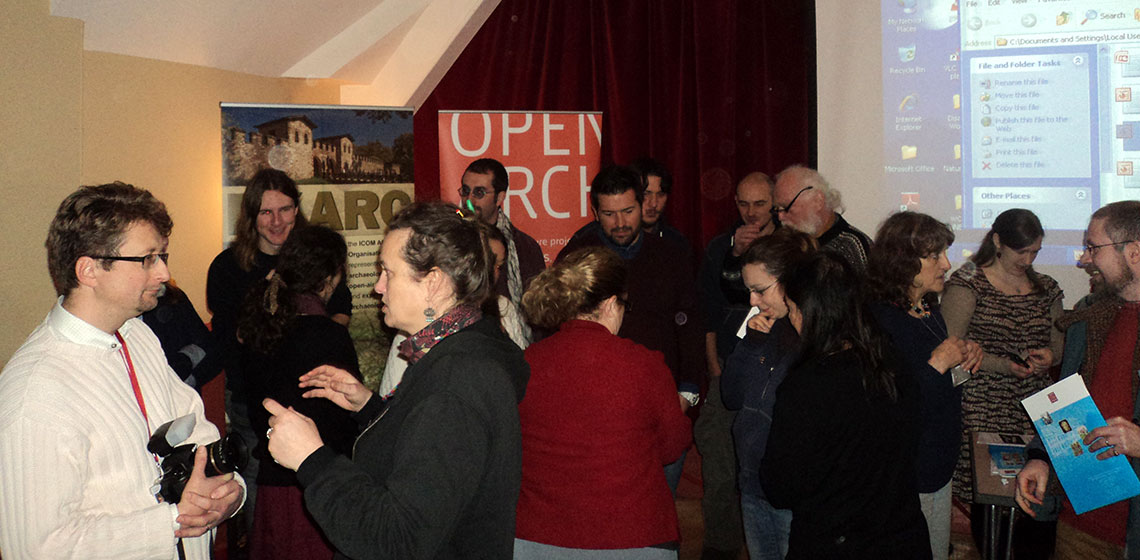
The 7th Experimental Archaeology Conference was held on 12-13th January 2013. This annual event, first held in 2006, has steadily increased in size. This year it was hosted jointly by the School of History, Archaeology and Religion at Cardiff University and St Fagan’s Open-Air Museum, near Cardiff. Seventy-five delegates originally booked to attend, but one hundred actually attended each day, a logistical challenge accommodated by the organisers that reflects the continued success and growing popularity of the conference. The conference consisted of two days of presentations, the first ending with poster presentations of diverse subjects that complemented the papers presented. A writer from Nature attended the first day.
The first day was hosted by the School of History, Archaeology and Religion at Cardiff University, based in the heart of Cardiff. There were diverse lectures discussing the creation and recognition of artefacts, the hands-on experience of recreation and the importance of statistical analysis in interpreting sites and finds. Some recreations such as the galley of the Mary Rose and the Bronze Age Boat at Falmouth are projects that will be more immediately recognisable to the public. Complementing these were presentations that examined the recreation, testing and interpretation of tools and the preservation of plant material through burning or its degradation through digestion, vital experiments undertaken within the framework of experimental archaeology. In addition, public presentation, in particular to audiences usually not reached by academic or other tradition archaeological media, was discussed with enthusiasm. The presenters were from a range of traditional and non-traditional backgrounds, including academics and students, museum and public presentation professionals, and specialists in the crafts and technology that they were presenting who had come to archaeology later, bringing a wealth of experience and knowledge that brought a wider understanding. This included the presentation of the reconstruction and evaluation of a method of medieval dentistry–a well-delivered lecture that had audience members squirming with recognition.
St Fagans Open-Air Museum hosted the second day, which consisted of lectures and then an afternoon of practical demonstrations set within the museum grounds. St Fagans is a museum of Welsh history and life, a setting for historically significant buildings to be preserved or reconstructed, which have been added to at a rate of one per year. The museum includes farmlife and working industry including live demonstrations of milling, weaving, clog making and blacksmithing. St Fagans is undergoing a renovation so delegates were able to see the ‘before’ ahead of the renovated ‘after’ due to reopen Spring 2013. The timeline represented will be extended back to 500,000 years in the past. New galleries will be constructed so that artefacts specific to Welsh history can be more accessibly displayed, in a new and better context with further reconstructions. A Bronze Age barrow will be constructed in association with a display showing its significance. The Celtic Village, constructed in 1992 by Peter Reynolds, was ground-breaking at the time, but is now being overhauled: a new form of house is to be constructed, testing the design. A Prince’s Hall, a copy of the Welsh Prince’s seat of government, will be constructed. It shall be two storey, 8m tall and provide a large venue for educational and other uses. Some delegates were learning for the first time the importance of Welsh history and identity, and St Fagans provided a good grounding for this.
The lectures of the second day were more in context with the site and each other. The role of the craftsperson and the importance of their craft knowledge in reconstructions was explored. Re-enactors’ perceptions of the buildings they were inhabiting were also examined – in particular how warm and liveable the buildings were. Perception also determines what is of importance, and experimental archaeology can be the factor that defines the criteria used to identify an artefact or a site. These presentations highlighted the human element of reconstructions, which can never be ignored. Presentations flowed easily between presenters, showing an ease and familiarity with the subject that comes from practice. All speakers kept to time and each presentation raised wider questions and discussion in the audience, both from those familiar with the subject and from those to whom it was entirely new. Such challenges keep the approach to the subject fresh and were most welcome.
Following the presentations, there were demonstrations scattered through the museum. This spacing meant that delegates had the opportunity to see more of the museum, the public could see the demonstrations and there was no crowding–each demonstrator had their own workspace in which to be viewed and approached with questions. In addition to the museum’s own friendly and informative demonstrators, delegates demonstrated bronze casting in a shelter in the Celtic Village, spinning and reconstructed wind instruments, flint knapping and horn working. There was overlap as the horn workers used some stone tools so these were located together. Due to the nature of bronze casting, the casters were exposed to the elements, but this did not dampen their spirits, and they took the traditional Welsh weather of torrential rain as part of the experience.
Choosing Cardiff as a venue had other advantages. Being the capital of Wales it has boundless hotels and connections for road and public transport, even if Welsh tradition means that there is little available early on a Sunday morning. There were many friendly pubs and restaurants, which delegates used to plan flexible schedules for travel and or to see other sites such as the National Museum, Cardiff Castle or the Torchwood (Dr Who) experience. The restaurant visited on the first night of the conference was attached to a microbrewery, in the shadow of the Millennium Stadium. It is not yet known where the venue will be for the 8th Experimental Archaeology Conference, due to be held January 2014, but it is sure to be as interesting as this year’s!